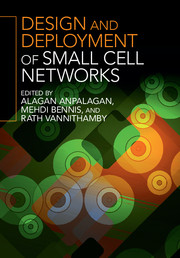Book contents
- Frontmatter
- Contents
- List of contributors
- Preface
- 1 Mobility performance optimization for 3GPP LTE HetNets
- 2 Design and performance analysis of multi-radio small cell networks
- 3 Dynamic TDD small cell management
- 4 3GPP RAN standards for small cells
- 5 Dense networks of small cells
- 6 Traffic offloading scenarios for heterogeneous networks
- 7 Required number of small cell access points in heterogeneous wireless networks
- 8 Small cell deployments: system scenarios, performance, and analysis
- 9 Temporary cognitive small cell networks for rapid and emergency deployments
- 10 Long-term evolution (LTE) and LTE-Advanced activities in small cell networks
- 11 Game theory and learning techniques for self-organization in small cell networks
- 12 Energy efficient strategies with BS sleep mode in green small cell networks
- 13 Mobility management in small cell heterogeneous networks
- 14 The art of deploying small cells: field trial experiments, system design, performance prediction, and deployment feasibility
- 15 Centralized self-optimization of interference management in LTE-A HetNets
- 16 Self-organized ICIC for SCN
- 17 Large-scale deployment and scalability
- 18 Energy efficient heterogeneous networks
- 19 Time- and frequency-domain e-ICIC with single- and multi-flow carrier aggregation in HetNets
- Index
- References
18 - Energy efficient heterogeneous networks
Published online by Cambridge University Press: 05 December 2015
- Frontmatter
- Contents
- List of contributors
- Preface
- 1 Mobility performance optimization for 3GPP LTE HetNets
- 2 Design and performance analysis of multi-radio small cell networks
- 3 Dynamic TDD small cell management
- 4 3GPP RAN standards for small cells
- 5 Dense networks of small cells
- 6 Traffic offloading scenarios for heterogeneous networks
- 7 Required number of small cell access points in heterogeneous wireless networks
- 8 Small cell deployments: system scenarios, performance, and analysis
- 9 Temporary cognitive small cell networks for rapid and emergency deployments
- 10 Long-term evolution (LTE) and LTE-Advanced activities in small cell networks
- 11 Game theory and learning techniques for self-organization in small cell networks
- 12 Energy efficient strategies with BS sleep mode in green small cell networks
- 13 Mobility management in small cell heterogeneous networks
- 14 The art of deploying small cells: field trial experiments, system design, performance prediction, and deployment feasibility
- 15 Centralized self-optimization of interference management in LTE-A HetNets
- 16 Self-organized ICIC for SCN
- 17 Large-scale deployment and scalability
- 18 Energy efficient heterogeneous networks
- 19 Time- and frequency-domain e-ICIC with single- and multi-flow carrier aggregation in HetNets
- Index
- References
Summary
Introduction
This chapter introduces novel approaches in heterogeneous networks (HetNets) where both large and small cells are deployed in a mixed manner to satisfy the increasing traffic demand and, at the same time, to improve the energy efficiency (EE) of future cellular networks.
In recent years, there has been a tremendous increase in the number of mobile handsets, in particular smart phones, supporting a wide range of applications, such as image and video transfer, cloud services, and cloud storage. The average smart phone usage rate has nearly been tripled and the overall amount of mobile data traffic demand grew 2.3 times in 2011 [1]. Furthermore, the amount of mobile data traffic is expected to increase dramatically in the coming years; recent forecasts are expecting the data traffic to increase more than 500 times in the next ten years [2, 3]. The current cellular systems would not be able to cope with the expected traffic demand increase. This huge amount of traffic demand leads to the need for further densification of the networks, for example in hotspot areas where traffic demand is concentrated as seen in Figure 18.1.
However, traffic load varies from time to time because of the typical night–day behavior due to the users’ daily activities in offices and being back to residential areas during the night [4]. In the current cellular networks, the power consumption of the radio access network (RAN) does not effectively scale with the traffic variations as shown in Figure 18.2. The traffic variations create the opportunities for the design of an adaptive network paradigm that can dynamically scale its power consumption according to the traffic variations.
Generally speaking, the power consumption of the RAN scales with the number of deployed base stations (BSs), each with offset power consumption. In cellular networks, only 10% of the overall power consumption stems from the user equipments (UEs) whereas nearly 90% of power consumption is incurred by the operator networks [5]. Figure 18.3 gives an idea on how the power consumption is distributed across the different parts of a typical cellular network. It is obvious that the RAN and the operation of data centers that provide computations, storage, applications, and data transfer are the most energy intensive parts of the entire network.
Information
- Type
- Chapter
- Information
- Design and Deployment of Small Cell Networks , pp. 462 - 483Publisher: Cambridge University PressPrint publication year: 2015
